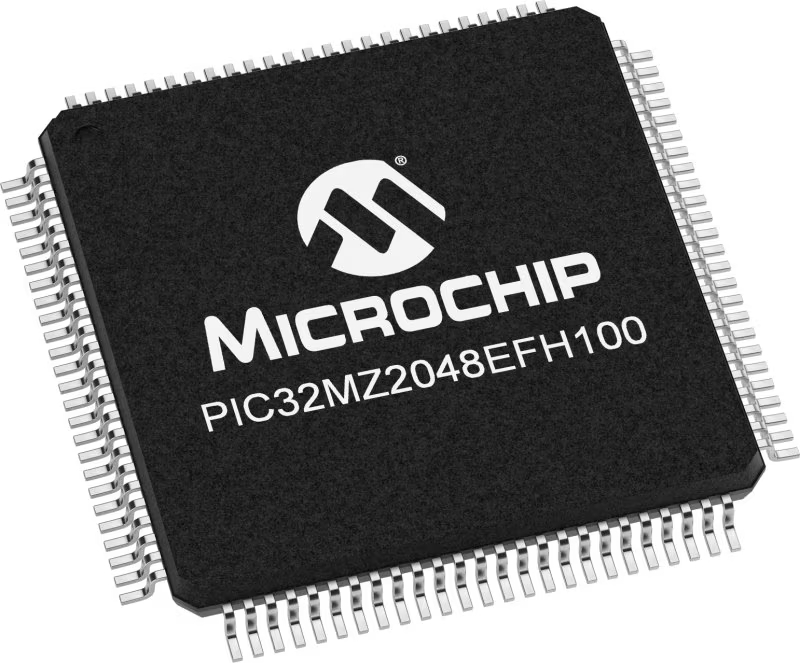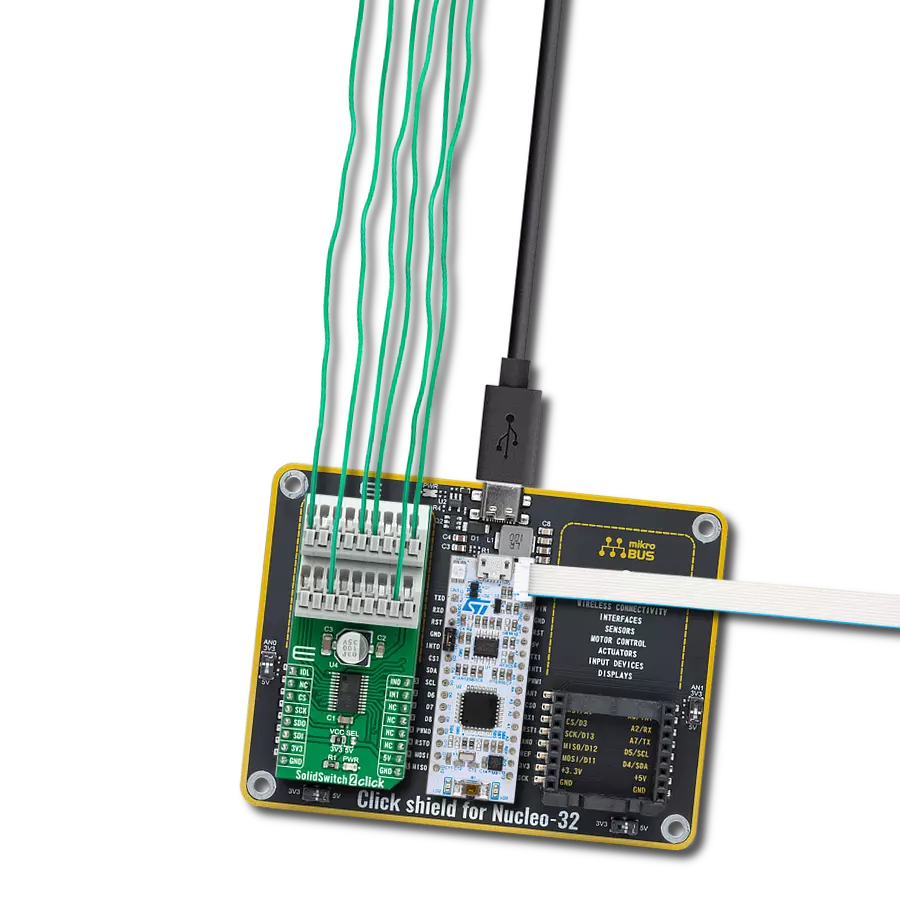Empower your projects with the versatility and precision of our current limiting solution, providing dynamic current management for improved safety, energy efficiency, and reliability
A
A
Hardware Overview
How does it work?
Current Limit 7 Click is based on the MAX14575A, a programmable current-limit switch featuring internal current limiting to prevent damage to host devices due to faulty load conditions from Analog Devices. The MAX14575A offers flexible protection boundaries for systems against input voltage ranging from 2.3V to 5.5V. It limits the output load current to a programmed level, up to 2.5A, making this device ideal for charging a large load capacitor and high-current load switching applications. Additional safety features include thermal shutdown protection to prevent overheating and reverse current blocking to prevent current from being driven back into the source. The current-limit switch provides a safe means for regulating the current delivered to a load circuit. It increases the load current to a programmed limit but no higher. Typically, the
current limit is a function of the voltage across an external resistor, and this voltage serves as the reference for an internal current-limiting amplifier. By replacing the resistor with a digital rheostat, you can easily program the current limit as performed on this Click board™. For this purpose, the AD5272 from Analog Devices, communicating with the MCU via a 2-wire I2C interface, is used to set the resistance on the MAX14575A SETI pin, adjusting the current limit for the switch. In this case, two rheostats were combined with an onboard switch labeled as RANGE, allowing the user to use two possible current limit ranges: from 0.5A to 2.5A and 0.25A to 0.5A. Current Limit 7 Click can be turned on, or off through the EN pin routed to the CS pin of the mikroBUS™ socket, hence offering a switch operation to turn ON/OFF power delivery to the connected load. It also provides an
overcurrent flag (FLG) indication signal routed to the INT pin of the mikroBUS™ socket and an additional reset signal for AD5272 digital rheostat routed to the RST pin of the mikroBUS™ socket. This Click board™ can operate with both 3.3V and 5V logic voltage levels selected via the VCC SEL jumper. It allows both 3.3V and 5V capable MCUs to use the communication lines properly. Additionally, there is a possibility for the MAX14575A power supply selection via jumper labeled as PWR SEL to supply the MAX14575A from an external power supply terminal in the range from 2.3V to 5.5V or with VCC voltage levels from mikroBUS™ power rails. Also, this Click board™ comes equipped with a library containing easy-to-use functions and an example code that can be used as a reference for further development.
Features overview
Development board
Flip&Click PIC32MZ is a compact development board designed as a complete solution that brings the flexibility of add-on Click boards™ to your favorite microcontroller, making it a perfect starter kit for implementing your ideas. It comes with an onboard 32-bit PIC32MZ microcontroller, the PIC32MZ2048EFH100 from Microchip, four mikroBUS™ sockets for Click board™ connectivity, two USB connectors, LED indicators, buttons, debugger/programmer connectors, and two headers compatible with Arduino-UNO pinout. Thanks to innovative manufacturing technology,
it allows you to build gadgets with unique functionalities and features quickly. Each part of the Flip&Click PIC32MZ development kit contains the components necessary for the most efficient operation of the same board. In addition, there is the possibility of choosing the Flip&Click PIC32MZ programming method, using the chipKIT bootloader (Arduino-style development environment) or our USB HID bootloader using mikroC, mikroBasic, and mikroPascal for PIC32. This kit includes a clean and regulated power supply block through the USB Type-C (USB-C) connector. All communication
methods that mikroBUS™ itself supports are on this board, including the well-established mikroBUS™ socket, user-configurable buttons, and LED indicators. Flip&Click PIC32MZ development kit allows you to create a new application in minutes. Natively supported by Mikroe software tools, it covers many aspects of prototyping thanks to a considerable number of different Click boards™ (over a thousand boards), the number of which is growing every day.
Microcontroller Overview
MCU Card / MCU

Architecture
PIC32
MCU Memory (KB)
2048
Silicon Vendor
Microchip
Pin count
100
RAM (Bytes)
524288
Used MCU Pins
mikroBUS™ mapper
Take a closer look
Click board™ Schematic

Step by step
Project assembly
Track your results in real time
Application Output
1. Application Output - In Debug mode, the 'Application Output' window enables real-time data monitoring, offering direct insight into execution results. Ensure proper data display by configuring the environment correctly using the provided tutorial.

2. UART Terminal - Use the UART Terminal to monitor data transmission via a USB to UART converter, allowing direct communication between the Click board™ and your development system. Configure the baud rate and other serial settings according to your project's requirements to ensure proper functionality. For step-by-step setup instructions, refer to the provided tutorial.

3. Plot Output - The Plot feature offers a powerful way to visualize real-time sensor data, enabling trend analysis, debugging, and comparison of multiple data points. To set it up correctly, follow the provided tutorial, which includes a step-by-step example of using the Plot feature to display Click board™ readings. To use the Plot feature in your code, use the function: plot(*insert_graph_name*, variable_name);. This is a general format, and it is up to the user to replace 'insert_graph_name' with the actual graph name and 'variable_name' with the parameter to be displayed.

Software Support
Library Description
This library contains API for Current Limit 7 Click driver.
Key functions:
currentlimit7_set_current_limit- Current Limit 7 set current limit functioncurrentlimit7_set_resistance- Current Limit 7 set resistance functioncurrentlimit7_get_fault- Current Limit 7 get fault function
Open Source
Code example
The complete application code and a ready-to-use project are available through the NECTO Studio Package Manager for direct installation in the NECTO Studio. The application code can also be found on the MIKROE GitHub account.
/*!
* @file main.c
* @brief CurrentLimit7 Click example
*
* # Description
* This library contains API for the Current Limit 7 Click driver.
* This driver provides the functions to set the current limiting conditions
* in order to provide the threshold of the fault conditions.
*
* The demo application is composed of two sections :
*
* ## Application Init
* Initialization of I2C module and log UART.
* After driver initialization, default settings turn on the device.
*
* ## Application Task
* This example demonstrates the use of the Current Limit 7 Click board™.
* Reading user's input from Usart Terminal and using it as an index
* for an array of pre-calculated values that define the current limit level.
* Results are being sent to the Usart Terminal, where you can track their changes.
*
* ## Additional Function
* - static void display_selection ( void )
*
* @author Nenad Filipovic
*
*/
#include "board.h"
#include "log.h"
#include "currentlimit7.h"
static currentlimit7_t currentlimit7;
static log_t logger;
// #define CURRENTLIMIT_MODE_250_mA_500_mA
#define CURRENTLIMIT_MODE_500_mA_2500_mA
const uint16_t limit_value_op[ 14 ] =
{
CURRENTLIMIT7_OP_1_CURRENT_LIMIT_510_mA,
CURRENTLIMIT7_OP_1_CURRENT_LIMIT_625_mA,
CURRENTLIMIT7_OP_1_CURRENT_LIMIT_860_mA,
CURRENTLIMIT7_OP_1_CURRENT_LIMIT_1320_mA,
CURRENTLIMIT7_OP_1_CURRENT_LIMIT_1450_mA,
CURRENTLIMIT7_OP_1_CURRENT_LIMIT_1550_mA,
CURRENTLIMIT7_OP_1_CURRENT_LIMIT_1750_mA,
CURRENTLIMIT7_OP_1_CURRENT_LIMIT_2020_mA,
CURRENTLIMIT7_OP_1_CURRENT_LIMIT_2260_mA,
CURRENTLIMIT7_OP_1_CURRENT_LIMIT_2500_mA,
CURRENTLIMIT7_OP_0_CURRENT_LIMIT_260_mA,
CURRENTLIMIT7_OP_0_CURRENT_LIMIT_280_mA,
CURRENTLIMIT7_OP_0_CURRENT_LIMIT_330_mA,
CURRENTLIMIT7_OP_0_CURRENT_LIMIT_450_mA
};
static void display_selection ( void )
{
log_printf( &logger, " To select current limit \r\n" );
log_printf( &logger, " Send one of the numbers: \r\n" );
log_printf( &logger, "- - - - - - - - - - - - - -\r\n" );
#ifdef CURRENTLIMIT_MODE_250_mA_500_mA
log_printf( &logger, " '0' - Limited to 260 mA \r\n" );
log_printf( &logger, " '1' - Limited to 280 mA \r\n" );
log_printf( &logger, " '2' - Limited to 330 mA \r\n" );
log_printf( &logger, " '3' - Limited to 450 mA \r\n" );
#else
log_printf( &logger, " '0' - Limited to 510 mA \r\n" );
log_printf( &logger, " '1' - Limited to 625 mA \r\n" );
log_printf( &logger, " '2' - Limited to 860 mA \r\n" );
log_printf( &logger, " '3' - Limited to 1320 mA \r\n" );
log_printf( &logger, " '4' - Limited to 1450 mA \r\n" );
log_printf( &logger, " '5' - Limited to 1550 mA \r\n" );
log_printf( &logger, " '6' - Limited to 1750 mA \r\n" );
log_printf( &logger, " '7' - Limited to 2020 mA \r\n" );
log_printf( &logger, " '8' - Limited to 2260 mA \r\n" );
log_printf( &logger, " '9' - Limited to 2500 mA \r\n" );
#endif
log_printf( &logger, "---------------------------\r\n" );
}
void application_init ( void )
{
log_cfg_t log_cfg; /**< Logger config object. */
currentlimit7_cfg_t currentlimit7_cfg; /**< Click config object. */
/**
* Logger initialization.
* Default baud rate: 115200
* Default log level: LOG_LEVEL_DEBUG
* @note If USB_UART_RX and USB_UART_TX
* are defined as HAL_PIN_NC, you will
* need to define them manually for log to work.
* See @b LOG_MAP_USB_UART macro definition for detailed explanation.
*/
LOG_MAP_USB_UART( log_cfg );
log_init( &logger, &log_cfg );
log_info( &logger, " Application Init " );
// Click initialization.
currentlimit7_cfg_setup( ¤tlimit7_cfg );
CURRENTLIMIT7_MAP_MIKROBUS( currentlimit7_cfg, MIKROBUS_1 );
if ( I2C_MASTER_ERROR == currentlimit7_init( ¤tlimit7, ¤tlimit7_cfg ) )
{
log_error( &logger, " Communication init." );
for ( ; ; );
}
if ( CURRENTLIMIT7_ERROR == currentlimit7_default_cfg ( ¤tlimit7 ) )
{
log_error( &logger, " Default configuration." );
for ( ; ; );
}
log_info( &logger, " Application Task " );
Delay_ms( 100 );
log_info( &logger, " Application Task " );
log_printf( &logger, "---------------------------\r\n" );
log_printf( &logger, " Current Limit 7 Click \r\n" );
log_printf( &logger, "---------------------------\r\n" );
Delay_ms( 100 );
#ifdef CURRENTLIMIT_MODE_250_mA_500_mA
currentlimit7_set_current_limit ( ¤tlimit7, CURRENTLIMIT7_OP_MODE_250_mA_500_mA, limit_value_op[ 10 ] );
log_printf( &logger, " >>> Selected mode %d \r\n", 0 );
log_printf( &logger, "- - - - - - - - - - - - - -\r\n" );
log_printf( &logger, " Current limit is %d mA \r\n", limit_value_op[ 10 ] );
log_printf( &logger, "---------------------------\r\n" );
Delay_ms( 100 );
#else
currentlimit7_set_current_limit ( ¤tlimit7, CURRENTLIMIT7_OP_MODE_500_mA_2500_mA, limit_value_op[ 0 ] );
log_printf( &logger, " >>> Selected mode %d \r\n", 0 );
log_printf( &logger, "- - - - - - - - - - - - - -\r\n" );
log_printf( &logger, " Current limit is %d mA \r\n", limit_value_op[ 0 ] );
log_printf( &logger, "---------------------------\r\n" );
Delay_ms( 100 );
#endif
display_selection( );
Delay_ms( 100 );
}
void application_task ( void )
{
static char index;
if ( CURRENTLIMIT7_ERROR != log_read( &logger, &index, 1 ) )
{
#ifdef CURRENTLIMIT_MODE_250_mA_500_mA
if ( ( index >= '0' ) && ( index <= '3' ) )
{
currentlimit7_set_current_limit ( ¤tlimit7, CURRENTLIMIT7_OP_MODE_250_mA_500_mA, limit_value_op[ index - 38 ] );
log_printf( &logger, " >>> Selected mode %d \r\n", index - 48 );
log_printf( &logger, "- - - - - - - - - - - - - -\r\n" );
log_printf( &logger, " Current limit is %d mA \r\n", limit_value_op[ index - 38 ] );
log_printf( &logger, "---------------------------\r\n" );
Delay_ms( 100 );
}
#else
if ( ( index >= '0' ) && ( index <= '9' ) )
{
currentlimit7_set_current_limit ( ¤tlimit7, CURRENTLIMIT7_OP_MODE_500_mA_2500_mA, limit_value_op[ index - 48 ] );
log_printf( &logger, " >>> Selected mode %d \r\n", index - 48 );
log_printf( &logger, "- - - - - - - - - - - - - -\r\n" );
log_printf( &logger, " Current limit is %d mA \r\n", limit_value_op[ index - 48 ] );
log_printf( &logger, "---------------------------\r\n" );
Delay_ms( 100 );
}
#endif
else
{
log_printf( &logger, " Data not in range! \r\n" );
log_printf( &logger, "---------------------------\r\n" );
display_selection( );
Delay_ms( 100 );
}
}
}
void main ( void )
{
application_init( );
for ( ; ; )
{
application_task( );
}
}
// ------------------------------------------------------------------------ END

































